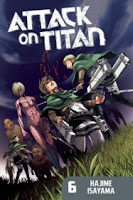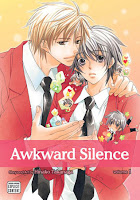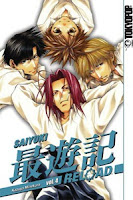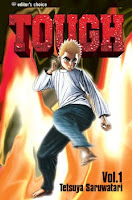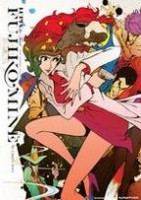My News and Reviews
Well, I somehow managed to post three reviews last week. This is a little unusual for me as normally I only have one or two ready to go. The first review was for Hinoki Kino’s No. 6, Volume 2. The pacing, characterization, and world-building improves on the first volume, which I was very glad to see. (I’m really hoping that the manga will have a better ending than the anime.) The second review was for Yoshiyuki Tomino’s Mobile Suit Gundam: Awakening, Escalation, Confrontation, an omnibus of a trilogy of early Gundam novels—the first part of the Gundam franchise to be officially released in English. (To be honest, though, I much prefer Yoshikazu Yasuhiko’s manga series Mobile Suit Gundam: The Origin.) I also reviewed Sherlock Bones, Volume 1 by Yuma Ando and Yuki Sato. I was very skeptical going into the series, but found the first volume of the manga to be surprisingly entertaining.
As for a few interesting things found online: Comic Natalie has announced the winners of its first annual manga awards. If you don’t read Japanese and can’t identify manga by their covers, Vertical compiled a list of the winners currently avilable in English (in addition to posting a hint for an as of yet unannounced Vertical license.) As reported by the Business Standard, Viz Media is apparently entering the market in India—Top Manga publisher set to make India entry. And if the relationship between Kodansha Comics, Del Rey/Del Rey Manga, and Random House has you confused, Kodansha posted a brief explanation/clarification of the situation on its Tumblr account.
Quick Takes
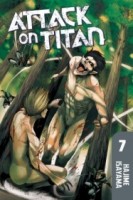 Attack on Titan, Volume 7 by Hajime Isayama. The terror in Attack on Titan has started to shift. At the beginning of the series the fear was much more about the unknown—the titans were these terrifying creatures beyond comprehension. But now the fear is coming from the knowledge that other humans may very well have a hand in what is happening. There have been plenty of deaths in Attack on Titan, but when those deaths involve characters who you’ve gotten a chance to know instead of just being nameless faces, suddenly the casualties carry even more weight. It makes the terror, frustration, and utter despair experienced by the characters even more palpable. Attack on Titan is dark, and it has been from the start, but the developments in the seventh volume pack quite a punch. I’ve had my doubts about the series in the past, and the artwork is still terribly inconsistent and occasionally difficult to follow, but I am hooked on it.
Attack on Titan, Volume 7 by Hajime Isayama. The terror in Attack on Titan has started to shift. At the beginning of the series the fear was much more about the unknown—the titans were these terrifying creatures beyond comprehension. But now the fear is coming from the knowledge that other humans may very well have a hand in what is happening. There have been plenty of deaths in Attack on Titan, but when those deaths involve characters who you’ve gotten a chance to know instead of just being nameless faces, suddenly the casualties carry even more weight. It makes the terror, frustration, and utter despair experienced by the characters even more palpable. Attack on Titan is dark, and it has been from the start, but the developments in the seventh volume pack quite a punch. I’ve had my doubts about the series in the past, and the artwork is still terribly inconsistent and occasionally difficult to follow, but I am hooked on it.
 Boxers & Saints written and illustrated by Gene Luen Yang, colors by Lark Pien. Boxers & Saints is easily one of the best comics that I’ve read this year. The two graphic novels that make up the duology can be read separately, but together they are even more powerful. The work is a retelling of the Boxer Rebellion—a violent uprising against foreign and Christian influence in northern China that took place at the turn of the 20th century. Boxers follows the life of a young man who becomes one of the leaders of the rebellion while Saints shows the conflict from the perspective of a young Chinese woman who converted to Christianity. Although very different in their details and narrative style, the two volumes follow a similar story arc as the characters come of age and find something to believe in, but are then challenged by those beliefs and conflicted over their decisions and actions. The Boxer Rebellion was a complicated and tragic event for both sides of the dispute. Boxers & Saints is a fictional account, but Yang put in a tremendous amount of research into the work. Highly, highly recommended.
Boxers & Saints written and illustrated by Gene Luen Yang, colors by Lark Pien. Boxers & Saints is easily one of the best comics that I’ve read this year. The two graphic novels that make up the duology can be read separately, but together they are even more powerful. The work is a retelling of the Boxer Rebellion—a violent uprising against foreign and Christian influence in northern China that took place at the turn of the 20th century. Boxers follows the life of a young man who becomes one of the leaders of the rebellion while Saints shows the conflict from the perspective of a young Chinese woman who converted to Christianity. Although very different in their details and narrative style, the two volumes follow a similar story arc as the characters come of age and find something to believe in, but are then challenged by those beliefs and conflicted over their decisions and actions. The Boxer Rebellion was a complicated and tragic event for both sides of the dispute. Boxers & Saints is a fictional account, but Yang put in a tremendous amount of research into the work. Highly, highly recommended.
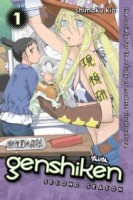 Genshiken: Second Season, Volumes 1-3 by Shimoku Kio. The Genshiken has turned into a fujoshi club. This doesn’t really bother me (I also enjoy BL and yaoi), but to an extent I do miss the greater variety of otaku that were represented in the original series. Still, even the fujoshi have their quirks and differences—the Genshiken has always attracted weirdos. And then there’s the cross-dressing Hato-kun, who for me is really stealing the show in the second season of Genshiken. The only male first-year to join the club, he’s created a very complete and convincing female persona. I find him to be the most interesting new character in the new series and he seems to be the focal point for much of the drama. I’m also particularly enjoying Yajima’s character development. She is uncomfortable with Hato’s cross-dressing but becomes very protective of him. As for the older characters, I was very happy to see Madarame return as he remains one of my favorites. Put him and Hato together in a scene and it’s just perfect.
Genshiken: Second Season, Volumes 1-3 by Shimoku Kio. The Genshiken has turned into a fujoshi club. This doesn’t really bother me (I also enjoy BL and yaoi), but to an extent I do miss the greater variety of otaku that were represented in the original series. Still, even the fujoshi have their quirks and differences—the Genshiken has always attracted weirdos. And then there’s the cross-dressing Hato-kun, who for me is really stealing the show in the second season of Genshiken. The only male first-year to join the club, he’s created a very complete and convincing female persona. I find him to be the most interesting new character in the new series and he seems to be the focal point for much of the drama. I’m also particularly enjoying Yajima’s character development. She is uncomfortable with Hato’s cross-dressing but becomes very protective of him. As for the older characters, I was very happy to see Madarame return as he remains one of my favorites. Put him and Hato together in a scene and it’s just perfect.
 Library Wars: Love & War, Volumes 9-10 by Kiiro Yumi. Perhaps it’s because I’m a librarian, but I can’t help but be fond of Library Wars even when it’s not always the strongest series. Sometimes the characters and their interactions are fantastic, and sometimes it seems as if they’re all acting like a bunch of high school students when they’re supposed to be mature, capable adults. Granted, there are some delightfully awkward scenes now that Iku has come to the realization that Dojo is her “prince.” He’s known for quite a while, but he doesn’t know that she knows, yet. It’s all rather amusing. I am very glad that Iku seems to be more competent now than she was at the beginning of the series. I don’t care how enthusiastic a person is, if they don’t have the needed skills for the job there’s not much hope for them. Library Wars is a fantasy, but it actually does address some real issues encountered in the library world. Censorship is the biggest one and at the core of the series, but things like sexual harassment and dealing with inappropriate patron behavior come up, too.
Library Wars: Love & War, Volumes 9-10 by Kiiro Yumi. Perhaps it’s because I’m a librarian, but I can’t help but be fond of Library Wars even when it’s not always the strongest series. Sometimes the characters and their interactions are fantastic, and sometimes it seems as if they’re all acting like a bunch of high school students when they’re supposed to be mature, capable adults. Granted, there are some delightfully awkward scenes now that Iku has come to the realization that Dojo is her “prince.” He’s known for quite a while, but he doesn’t know that she knows, yet. It’s all rather amusing. I am very glad that Iku seems to be more competent now than she was at the beginning of the series. I don’t care how enthusiastic a person is, if they don’t have the needed skills for the job there’s not much hope for them. Library Wars is a fantasy, but it actually does address some real issues encountered in the library world. Censorship is the biggest one and at the core of the series, but things like sexual harassment and dealing with inappropriate patron behavior come up, too.
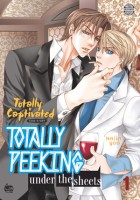 Totally Peeking Under the Sheets, Volumes 1-2 by Hajin Yoo. Totally Peeking Under the Sheets is a collection of side stories relating to Yoo’s boys’ love manwha Totally Captivated. It’s definitely intended for those who have read and enjoyed the original series. The first volume contains quite a few short manhwa, some of them only a few pages long. Many of these stories emphasize the more humorous aspects of Totally Captivated and its characters. And as might be expected from the title Totally Peeking Under the Sheets, several stories are also rather racy—what little plot there is is used to get Ewon and Mookyul into bed with each other. (Not that that’s very difficult.) The focus of the second volume is a much longer sequel manhwa called “The Final Chapter.” Although there were some great character moments, the story felt forced to me. Ewon suddenly has to deal with his family, particularly the mother who abandoned him. I’m not sure the situation would have really played out in the way that Yoo presents it. Overall, I much preferred the first volume.
Totally Peeking Under the Sheets, Volumes 1-2 by Hajin Yoo. Totally Peeking Under the Sheets is a collection of side stories relating to Yoo’s boys’ love manwha Totally Captivated. It’s definitely intended for those who have read and enjoyed the original series. The first volume contains quite a few short manhwa, some of them only a few pages long. Many of these stories emphasize the more humorous aspects of Totally Captivated and its characters. And as might be expected from the title Totally Peeking Under the Sheets, several stories are also rather racy—what little plot there is is used to get Ewon and Mookyul into bed with each other. (Not that that’s very difficult.) The focus of the second volume is a much longer sequel manhwa called “The Final Chapter.” Although there were some great character moments, the story felt forced to me. Ewon suddenly has to deal with his family, particularly the mother who abandoned him. I’m not sure the situation would have really played out in the way that Yoo presents it. Overall, I much preferred the first volume.
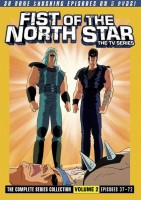 Fist of the North Star: The TV Series, Volume 2 (Episodes 37-72) directed by Toyoo Ashida. While the first collection of the Fist of the North Star anime series had quite a bit of filler, the second collection starts to really dig into the plot and characters. The series is much better for it. Plus, the anime has now reached a point in the story beyond the manga that was released in English. Some of the fights do still get to be a little repetitive, especially when the protagonists face off against large groups of unnamed bad guys and minions, but there’s always something about each battle that makes it stand out from the rest. The best fights, though, are those that occur between two martial arts masters. But Fist of the North Star isn’t just about power, skill, and strength (although that’s certainly an important part of it). The series is also about destiny, loyalty, friendship, and love. Kenshiro is a tragic hero who continues to lose those who are close to him. Fist of the North Star is a post-apocalyptic martial arts epic, and I’m loving it.
Fist of the North Star: The TV Series, Volume 2 (Episodes 37-72) directed by Toyoo Ashida. While the first collection of the Fist of the North Star anime series had quite a bit of filler, the second collection starts to really dig into the plot and characters. The series is much better for it. Plus, the anime has now reached a point in the story beyond the manga that was released in English. Some of the fights do still get to be a little repetitive, especially when the protagonists face off against large groups of unnamed bad guys and minions, but there’s always something about each battle that makes it stand out from the rest. The best fights, though, are those that occur between two martial arts masters. But Fist of the North Star isn’t just about power, skill, and strength (although that’s certainly an important part of it). The series is also about destiny, loyalty, friendship, and love. Kenshiro is a tragic hero who continues to lose those who are close to him. Fist of the North Star is a post-apocalyptic martial arts epic, and I’m loving it.

